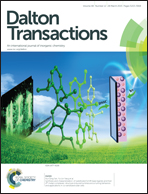Influence of the ligand frameworks on the coordination environment and properties of new phenylmercury(ii) β-oxodithioester complexes†
Abstract
New phenylmercury(II) complexes of the form [PhHg(L1), PhHg(L2) and PhHg(L3)] (L1 = methyl-3-hydroxy-3-(p-methoxyphenyl)-2-propenedithioate (1), L2 = methyl-3-hydroxy-3-(p-bromophenyl)-2-propenedithioate (2) and L3 = methyl-3-hydroxy-(3-pyridyl)-2-propenedithioate (3)) have been synthesized and characterized by elemental analysis, IR, UV-Vis, 1H and 13C NMR. The crystal structures of 1–3 reveal a linear geometry about the mercury atom via ipso-C and S11 atoms. 1 and 2 exhibited O,S-coordination whereas 3 preferred S,S-coordination. Intramolecular Hg⋯O bonding interactions are also observed in 1 and 2 at distances of 2.638(14), 2.644(10) Å respectively. However in 3, incorporation of the 3-pyridyl substituent on the ligand enhanced the proximity of S13 and N14, giving rise to significant intramolecular Hg⋯S and intermolecular Hg⋯N interactions at 3.141(5) Å and 2.77(2) Å respectively generating a 1-D polymeric chain motif. The O,S- or S,S-coordination preference and Hg⋯N interactions have been assessed by DFT calculations. All the complexes show metal perturbed ligand-centred luminescence characteristics in solution and in the solid phase. The band gap values 2.54, 2.66 and 2.61 eV for 1, 2 and 3, respectively, evaluated from the diffuse reflectance spectroscopy show the semiconducting nature of the complexes.


 Please wait while we load your content...
Please wait while we load your content...